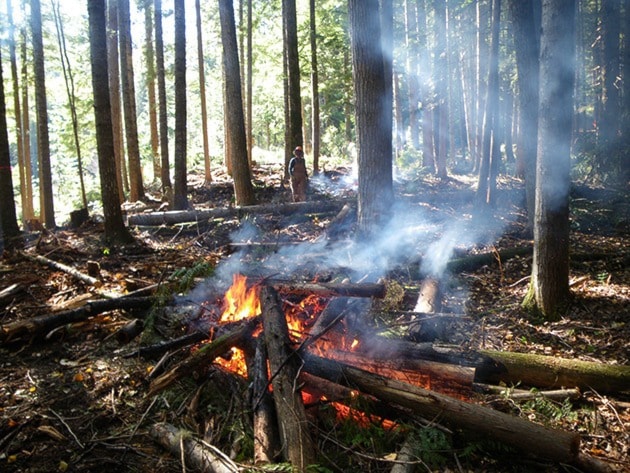A forester with expertise in wildfire and fuel management says Nelson sits between seven and 10 on the provincial government’s 10-point scale that measures wildfire threat to communities.
“Nelson is a fairly high risk area,” says Bruce Blackwell, who is working for a local government partnership on a new wildfire management plan for the Nelson area.
“Fort Mac was a game changer because it woke everybody up,” he says. “I don’t want everybody to go back to sleep if we have a rainy fire season. This [wildfire management plan] is a 20-year project to get to a point where we can protect Nelson to the best of our ability. But if we don’t get on this train we are going to see communities in BC burn. I don’t know where and when, but I know it will happen.”
Blackwell says we have been too successful at suppressing fires for the past 100 years.
“There is a large amount of fuel on the landscape now. A lot of these stands are older and they create more shade which is favourable to more cedar coming up so there are ladder fuels that enable fires to spread from the forest floor into the crowns.”
Blackwell says in earlier years, frequent fires “thinned the stands and the crowns so fire wouldn’t spread at the scale we could get to now. Now you have a very contiguous, very homogeneous landscape, and as you saw in the Sitkum fire last year, large parts of it are susceptible to crown fire.”
As for climate change, Blackwell says the situation would be urgent even without it.
“Maybe we had 30 to 40 days of high and extreme fire hazard (in the past). In a world of climate change we are probably moving to 50 to 60 days.”
Much depends on private landowners
Blackwell says people are wrong to think this is a problem just for government. Much of the forest around Nelson is privately owned, and he says some of it is dangerously neglected. Part of his job involves going out and talking to private landowners to make them aware of the risk. But he can’t force them to act.
“All we need is one house fire on one piece of private property where there is a lot of fuel and a lot of hazard, and that is going to spread onto the greater landscape. So the biggest education message here is that this is a shared responsibility.
“Whether they [private landowners] have the funds to treat these parcels or do something about it is a whole other story, but certainly they are learning about the hazards related to their properties and understanding the risk, which is a first step.”
But Blackwell says this kind of education is a big job and “we are not there yet. Getting them to focus on it, that is the challenge.”
What could private landowners do to reduce the risk? Blackwell points to work done over the past few years by the city and regional district in areas such as Rosemont Park and below the rail trail.
“We remove the dead and dying wood and remove surface fuel. But there are trees you want to retain, and others you want to take out. We want to leave the right species because some are more fire tolerant, some are more flammable. We want to come to a certain density, a certain live crown height off the ground. You have to meet a certain threshold that would limit fire from spreading from the surface into the crown, so if a crown fire came into Nelson it would hit that treated area and go to ground.”
He says other treatment strategies involve protecting critical infrastructure like communication towers and water sources. He cites a community in Colorado that spent $10-million following a fire to put in a water treatment plant.
“There would be a similar situation in Nelson if there was a fire in West Arm Park [the source of Nelson’s water].”
The City of Nelson’s efforts in this collaboration are led by fire Chief Len MacCharles. He sometimes visits landowners to help them clarify their fire protection priorities.
“We start right at the home: what is your home made of? Wood siding and wood shakes can be a real challenge in terms of embers, and we talk about when you replace your roof you might want to change from shakes. How close are plants to your home? Certainly trees pose more challenges if they are coniferous. And we look at things like having gutters full of leaves and twigs. In the gutters for example, imagine a whole bunch of dead cedar twigs or grass or leaves, and a fire dropping embers in those gutters or along your deck where dry grasses are … that is the sort of thing that causes havoc.”
Then MacCharles says he looks at the next 100 feet from the house. Some plants and trees are better than others. He recommends pruning up from the ground to avoid low-hanging branches. He also discusses the advantages of sprinkler systems.
A completed plan this summer
Blackwell says he’ll have a draft plan ready for public viewing by the end of August. The plan will be a prescription for what local governments and BC Parks should do over the next few years to keep the city and its surroundings safe from fire.
The plan will cover an analysis of the wildland-urban interface as well as action plans for communication and education, structure protection, emergency response, training and equipment, vegetation management, and post-fire rehabilitation.
